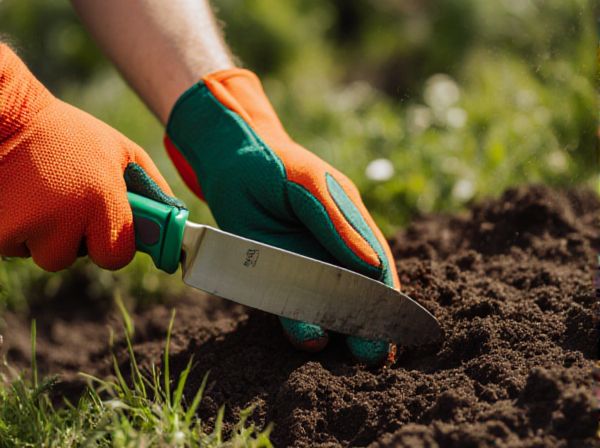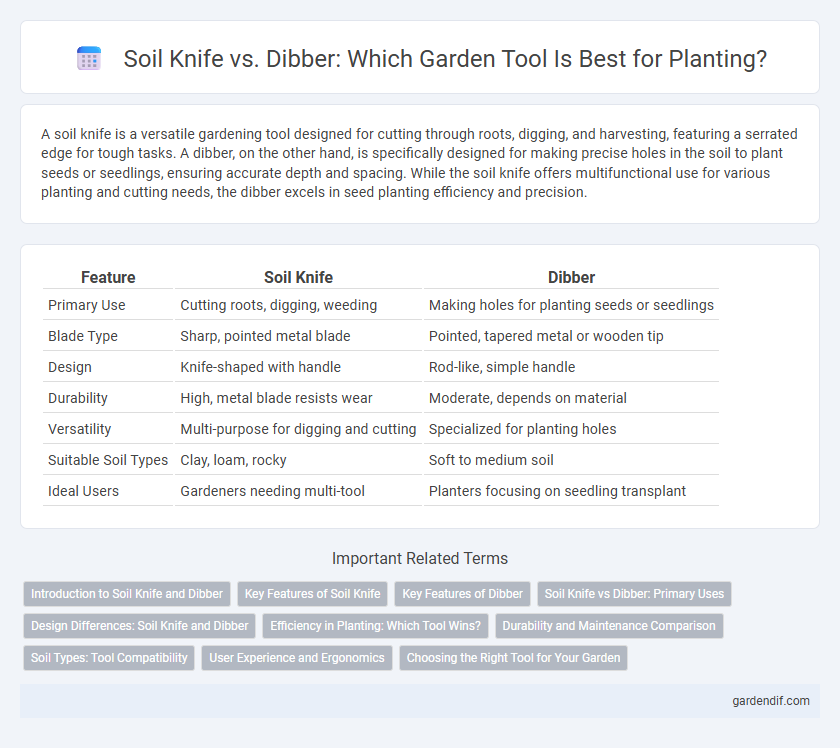
Soil knife vs dibber Illustration
A soil knife is a versatile gardening tool designed for cutting through roots, digging, and harvesting, featuring a serrated edge for tough tasks. A dibber, on the other hand, is specifically designed for making precise holes in the soil to plant seeds or seedlings, ensuring accurate depth and spacing. While the soil knife offers multifunctional use for various planting and cutting needs, the dibber excels in seed planting efficiency and precision.
Table of Comparison
| Feature | Soil Knife | Dibber |
|---|---|---|
| Primary Use | Cutting roots, digging, weeding | Making holes for planting seeds or seedlings |
| Blade Type | Sharp, pointed metal blade | Pointed, tapered metal or wooden tip |
| Design | Knife-shaped with handle | Rod-like, simple handle |
| Durability | High, metal blade resists wear | Moderate, depends on material |
| Versatility | Multi-purpose for digging and cutting | Specialized for planting holes |
| Suitable Soil Types | Clay, loam, rocky | Soft to medium soil |
| Ideal Users | Gardeners needing multi-tool | Planters focusing on seedling transplant |
Introduction to Soil Knife and Dibber
A soil knife is a versatile gardening tool designed for digging, cutting roots, and transplanting with a sharp, curved blade and ergonomic handle. A dibber, in contrast, is primarily used for making precise holes in the soil for planting seeds or seedlings, featuring a pointed, cylindrical shape. Both tools are essential for different stages of planting and soil preparation, optimizing gardening efficiency.
Key Features of Soil Knife
Soil knives feature a serrated edge for cutting through roots and tough soil, along with a durable, corrosion-resistant stainless steel blade designed for heavy-duty gardening tasks. Ergonomically designed handles provide comfort and reduce hand fatigue, while the multipurpose blade enables digging, cutting, and scraping in various soil types. This versatility makes soil knives more efficient than dibbers, which are primarily used for making planting holes in softer soil.
Key Features of Dibber
Dibbers are essential gardening tools designed for creating precise holes in soil for seeds and seedlings, featuring a tapered, pointed tip that allows for easy penetration in various soil types. They often have ergonomic handles to ensure comfortable grip and control during planting tasks, enhancing accuracy and reducing hand fatigue. Unlike soil knives, dibbers specialize in depth control and uniform hole creation, making them ideal for efficient and consistent seed placement.
Soil Knife vs Dibber: Primary Uses
A soil knife excels in cutting through roots, digging small holes, and slicing through tough soil, making it ideal for transplanting and weeding tasks. Dibbers are primarily used for creating uniform holes for seeds or seedlings, ensuring precise depth and spacing in gardening or farming. The soil knife offers versatility for general soil manipulation, while the dibber specializes in consistent planting hole creation.
Design Differences: Soil Knife and Dibber
Soil knives feature a serrated edge and a curved blade designed for cutting through roots and tough soil, offering versatility in digging, slicing, and weeding tasks. Dibbers have a pointed, tapered design optimized for creating precise planting holes, ensuring consistent depth for seeds or seedlings. The soil knife's multifunctional blade contrasts with the dibber's singular purpose, emphasizing different ergonomic and functional design priorities.
Efficiency in Planting: Which Tool Wins?
Soil knives offer superior efficiency in planting by combining cutting, digging, and weeding functions into one versatile tool, significantly speeding up soil preparation and seed placement. Dibbers excel in creating precise holes for seeds or seedlings, especially in tightly spaced or delicate planting scenarios, ensuring uniform depth and spacing with minimal soil disturbance. For larger-scale or varied planting tasks, the soil knife typically outperforms the dibber due to its multifunctional design and adaptability.
Durability and Maintenance Comparison
Soil knives feature high-carbon steel blades known for superior durability and rust resistance, requiring minimal maintenance beyond occasional cleaning and sharpening. Dibbers, often made from stainless steel or durable plastic, offer moderate durability but may wear down faster under heavy use and require periodic inspection for cracks or rust. Comparing both, soil knives generally provide longer-lasting performance with less upkeep, making them a preferable choice for frequent, demanding gardening tasks.
Soil Types: Tool Compatibility
Soil knives excel in compact and rocky soils, offering durability and precision for cutting roots and penetrating hard ground. Dibbers are ideal for loose, sandy, or loamy soils where their pointed design easily creates uniform holes for planting seeds or seedlings. Choosing the right tool based on soil type enhances planting efficiency and tool longevity.
User Experience and Ergonomics
Soil knives feature curved blades and comfortable, slip-resistant handles designed to reduce hand fatigue during extended use, making them ideal for cutting roots and digging in tough soil. Dibbers offer a simpler design with pointed tips and lightweight construction, allowing precise planting with minimal strain but less versatility. Ergonomically, soil knives provide enhanced grip and leverage for diverse gardening tasks, whereas dibbers prioritize ease of insertion and control for seed or bulb planting.
Choosing the Right Tool for Your Garden
Choosing the right garden tool depends on your specific planting needs; a soil knife offers versatility for cutting roots, digging, and weeding, while a dibber excels at making precise holes for seeds and bulbs. For gardeners prioritizing multitasking efficiency and soil manipulation, a soil knife is ideal, but for accurate planting depth and spacing, a dibber provides superior control. Incorporating both tools can optimize garden tasks by combining the soil knife's adaptability with the dibber's planting precision.
Soil knife vs dibber Infographic

 gardendif.com
gardendif.com